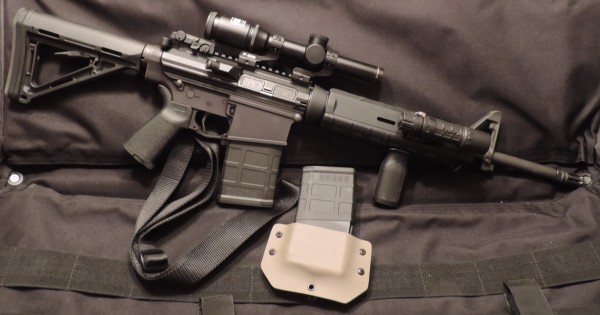
Bushmaster . 308 ORC MOE Carbine. Nikon 1-4 Scope with Nikon P Series Mount. Magpul M3 PMags, Vltor Scout Mount with Surefire G2 Light, HST Sling, MDFA Kydex FDE .308 Mag Pouch.
Having been a long time user (37 years) of the M-16/AR-15 family in 5.56, I decided that it was time I tried one in the caliber that the weapon was originally designed for .308. I’m a proponent of 30 caliber weapons and the .308 and 30-06 are my favorites. While the 5.56/.223 work well within certain situations, I wanted a more versatile caliber, with the ability to penetrate barriers as well as one that has more effect on target in a defensive situation. We also have large animals here in Maine and the 5.56 is somewhat lacking in it’s ability to address those situations.(Ever have to shoot an injured Moose?)
While the 6.8 SPC .300 Blackout and 6.5 Grendel have shown promising results, I wanted a caliber that I could find and afford to shoot in training.
I also wanted to keep the skill sets I’ve built with the AR system, rather than using a different system such as the HK-93 PTR-91 and Springfield Armory M1A. While I’ve owned and used all of them and they’re fine weapons, the manual of arms is obviously quite different than the AR family.
While researching the available options I found that my local gun shop had a new Bushmaster ORC MOE .308 Carbine. The price was right and it had the features that I wanted. Flattop receiver, Standard Front Sight, MagPul MOE furniture and flip up rear sight as well as the ability to use PMags and other readily available magazines. It also uses a 16in. barrel with a mid length gas tube. This helps to keep the weapon more compact, and enhances function and lessens the beating on the gun and shooter over a carbine length system.
The 16 inch heavy contour barrel has a chrome lined bore and chamber and a 1 in 10 twist to better stabilize heavy bullets. My rifle shows a definite preference for 168 gr. bullets.

100 yards shot off a bench- 10 168 gr. BTHP reloads. The lower right group is 4 rounds with the left flyer. The center group was fired after a scope adjustment, with 4 rounds center and the upper flyer.
As you can see from the target photo the rifle is a sub MOA shooter if I do my part. PMC 147gr. FMJBT shot into 2 1/2 inch groups and functioned well. 168 gr. bullets are clearly the way to go for the best accuracy.
The trigger is a 2 stage design and the pull is 8lbs.2oz. on my Lyman trigger pull gauge.
Function and controls are pure AR style. Think of it as an AR on steroids. The bolt and BCG are massive compared to a 5.56 as they need to be for the .308 round. This does add up in total weight of the weapon. The factory weight is 7.92 lbs. Mine is 11lbs. 2oz. as you see it set up with a loaded 20 round magazine. While heavy compared to most 5.56 versions. (Depending on how many gadgets the owner has added.) The balance is very neutral. An extended bench shooting session, or rapid fire makes the weight somewhat welcome however.
During the first shooting session I had 2 FTF malfunctions which occurred with the factory supplied magazine. This was within the first 7 rounds fired of PMC ammo. Since that time, I’ve had no malfunctions.
While setting the weapon up I wanted to keep it as versatile as possible. While not as short and light as some carbines or as specialized as many long range tactical rifles, I believe it makes a formidable weapon system which will meet my needs in a powerful accurate package in a wide range of situations.
Evaluate your needs and your potential defensive situations. Maybe a .308 Carbine is just what you need.
Stay tuned for more reviews as testing continues.
Stay Safe



While it will look funny in the woods, with a five round mag, you could make a seamless transition from tact carbine to deer rifle. I like the idea.
I have thought about that too, but they also tend to be heavier as well. I guess I’ll just have to have both!
Anyone who studies projectile stability and the miller formula knows that 11 is the best twist for a 308 setup like this. The problem is that most manufacturers are completely ignorant of such things, or given the benefit of the doubt at least consider then inconsequential trivialities – and it’s really just sad. Yes there is such a thing as overstabilized via too fast a twist. An 11 would stabilize anything this rifle would ever be capable of shooting at a reasonable velocity – better than a 10. Most people will consider this stupid and splitting hairs but if you want the absolute best you can get you need to pay attention to these small details, unlike most manufacturers.
Actually, there have been a variety of experiments done over the past few years that show a faster twist is a much better option, especially as barrels get shorter–for example running a 1/8 twist 16″ .308 barrel has proven to offer better long range accuracy and terminal performance than slower twists.
Doc I trust your knowledge implicitly and would love to look into the studies.
But what you say still proves that manufacturers really aren’t paying attention to these details as I’ve yet to see a 8 twist 308 “shorty” anywhere.
Gentlemen
I won’t argue ballistics with you regarding twist rates. But I do know I’m happy with 2-4 shot 1/2 MOA groups, not counting the flyers which were more than likely the first chambered round from the magazine in each group. Or my less than young eyes…
Be Safe
Bob